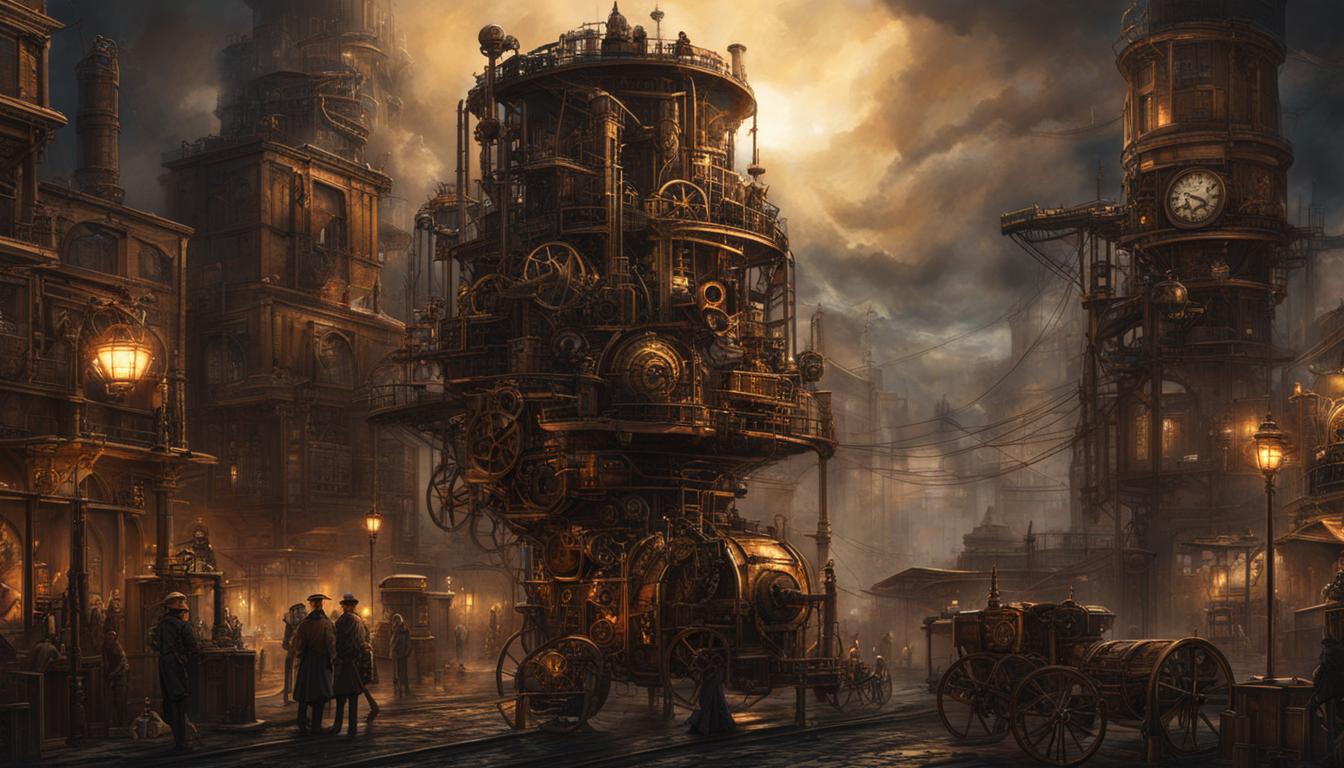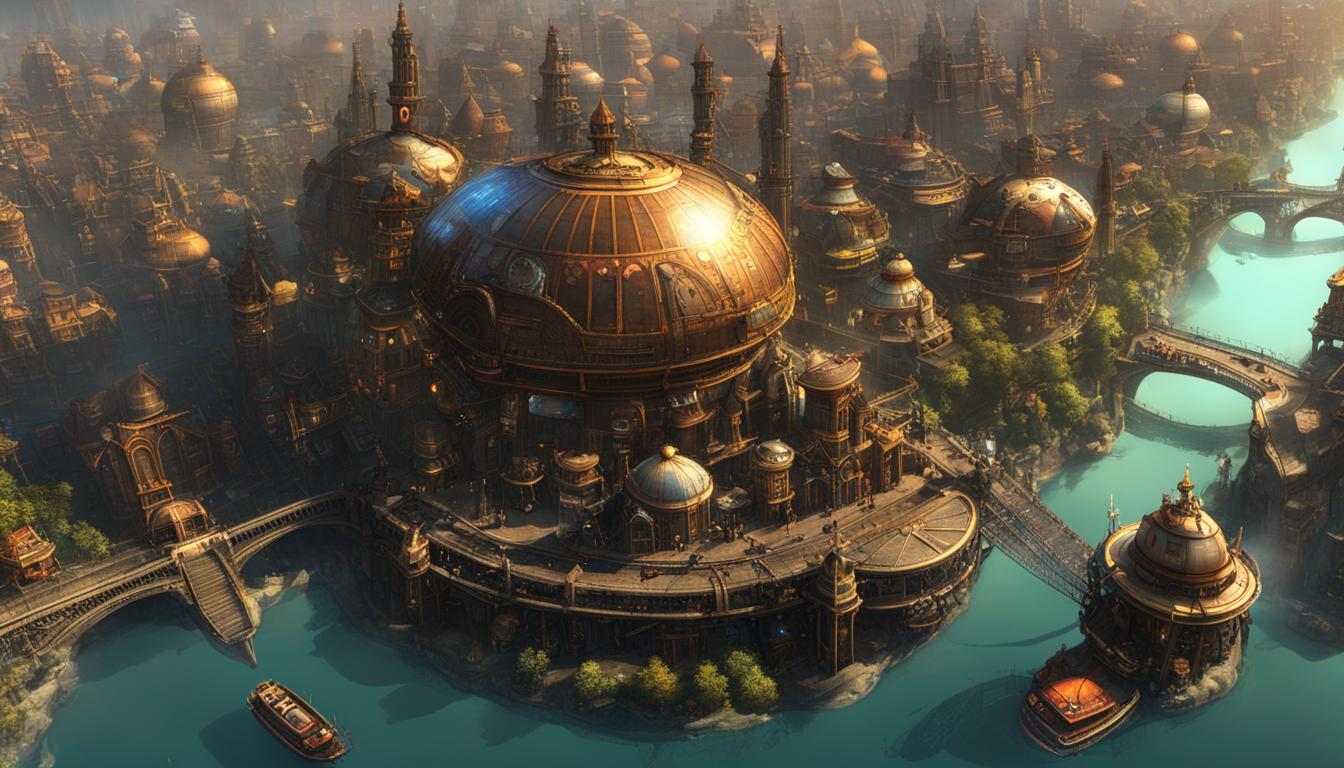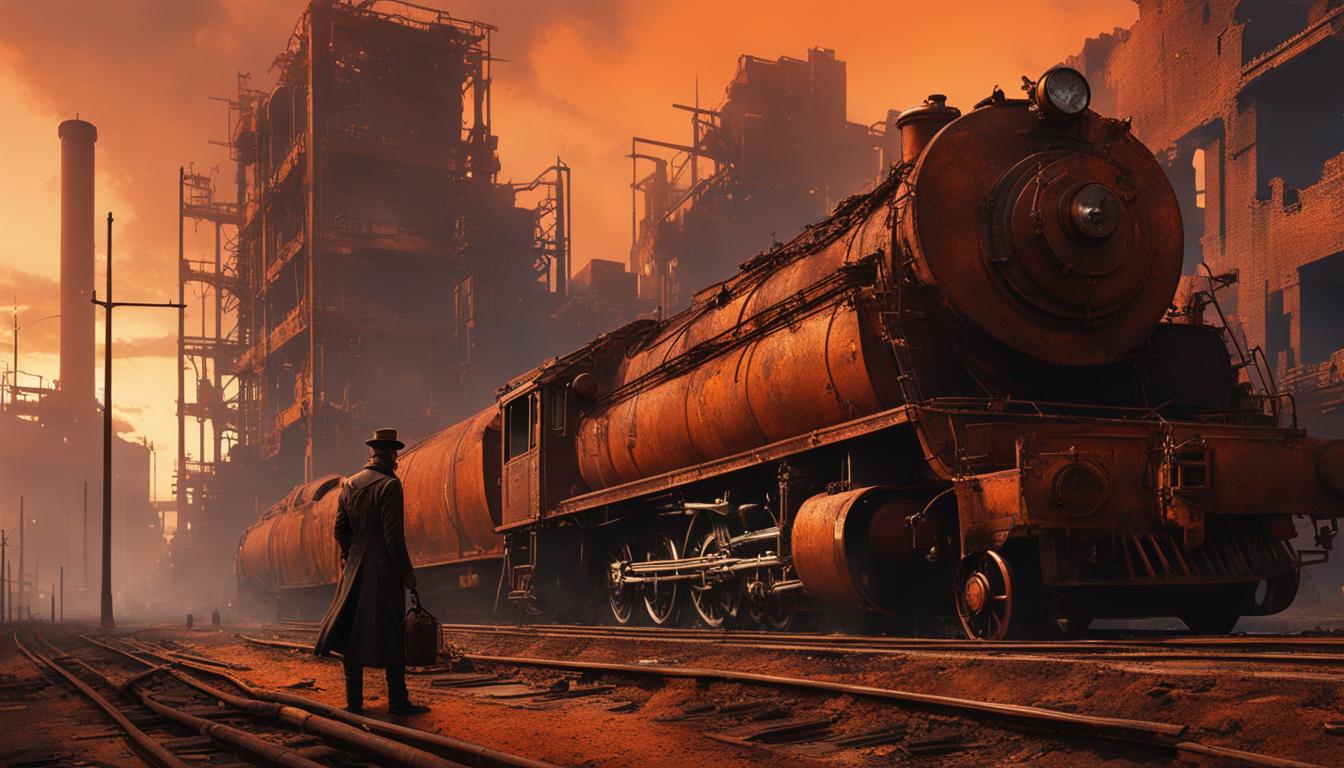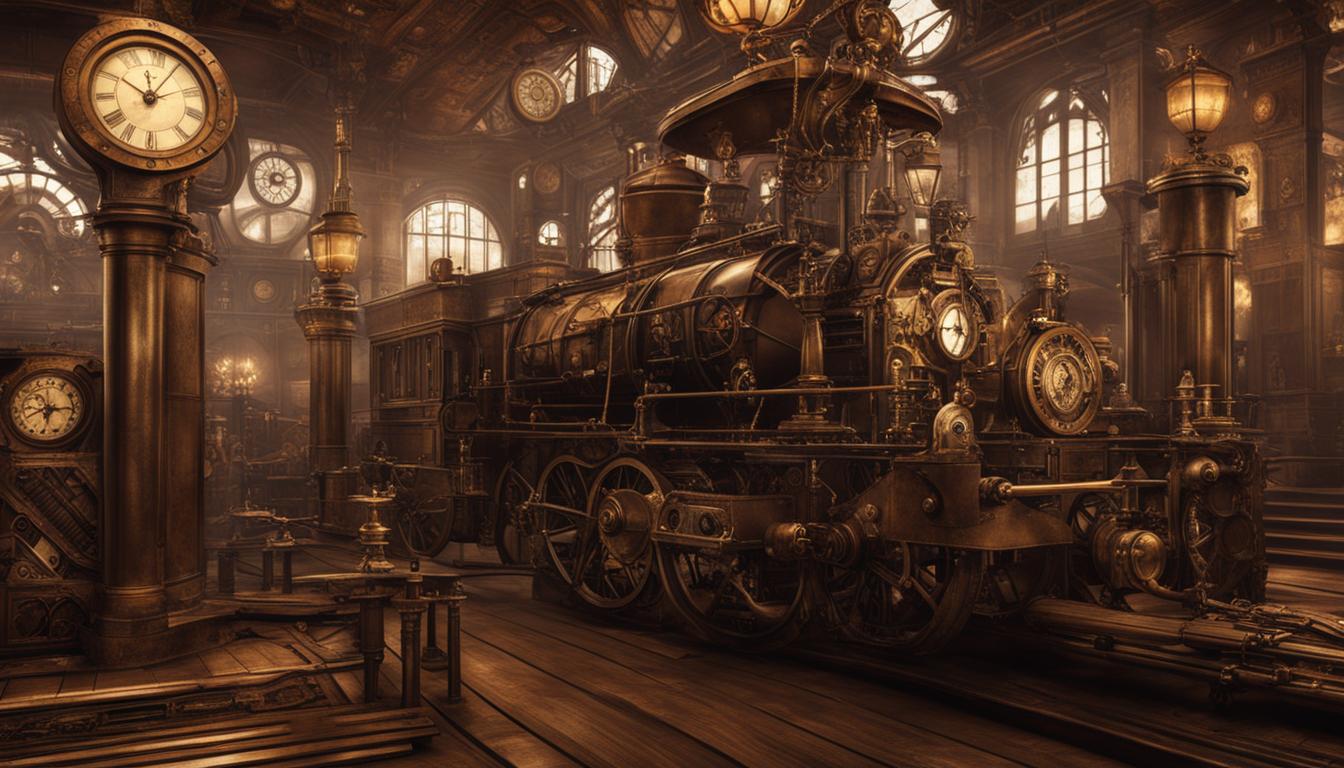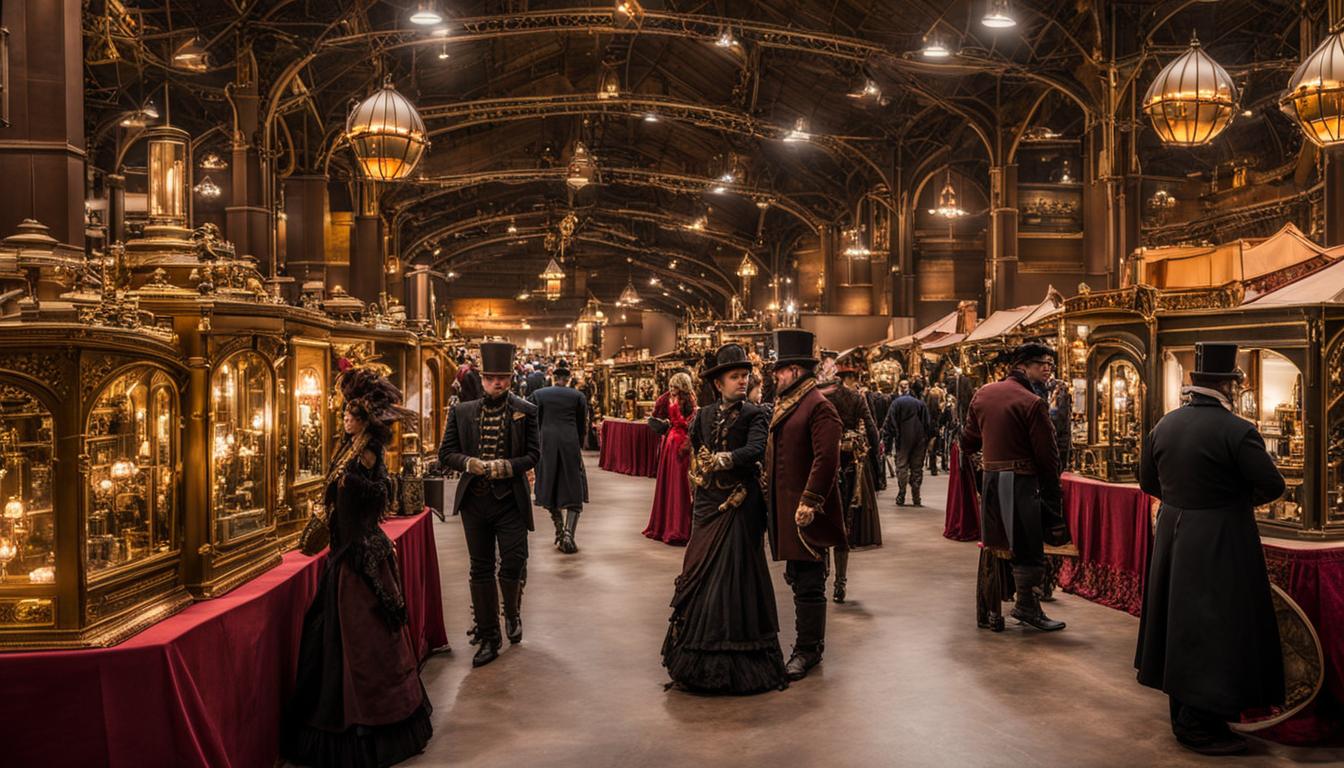Steampunk stories have captivated readers with their imaginative portrayal of technology. From aether and analog systems to automatons and clockwork mechanisms, steampunk narratives weave a unique blend of historical aesthetics and futuristic elements. In this article, we will explore the fascinating role of technology in the world of steampunk and how it shapes the genre’s charm and allure.
Key Takeaways:
- Steampunk narratives depict technology in a creative and adventurous way.
- Elements like aether, analog systems, and automatons contribute to the distinct charm of steampunk.
- Clockwork mechanisms, flying machines, and rayguns add to the technological wonder of the genre.
- Steampower and time machines play vital roles in shaping the steampunk world.
- Technology in steampunk stories showcases the creativity and innovation of the genre.
Aether and Analog Systems in Steampunk
Steampunk narratives are known for their imaginative incorporation of technology, and two key elements that contribute to the unique worldbuilding are aether and analog systems. Aether, a classical element often associated with the sky or heavens, takes on a mysterious and versatile role in steampunk stories. It can serve as a power source, providing energy for various contraptions and inventions, or be blamed for the occurrence of natural disasters. The concept of aether in steampunk adds an ethereal touch to the narrative and enhances the overall sense of wonder and magic.
On the other hand, analog systems play a vital role in distinguishing the steampunk setting from our digital world. In an era where digital technology reigns supreme, steampunk embraces a more nostalgic approach with the use of analog systems. These systems rely on traditional waveforms and mechanical mechanisms, rather than converting them into digital data. By employing analog systems, authors create a distinct and charming atmosphere that transports readers to a time when technology was simpler, yet no less fascinating.
Table: Aether vs. Analog Systems
| Aether | Analog Systems |
|---|---|
| • Mysterious and versatile | • Nostalgic and charming |
| • Can be used as a power source | • Relies on traditional waveforms and mechanisms |
| • Provides a sense of wonder and magic | • Creates a unique atmosphere |
The interplay between aether and analog systems in steampunk narratives adds depth and richness to the technological aspects of the genre. It showcases the creativity of authors in blending historical aesthetics with speculative elements, resulting in a captivating and immersive reading experience.
Automatons and Clockwork Systems in Steampunk
In the fascinating world of steampunk, automatons and clockwork systems take center stage, adding a touch of mechanical marvel to the genre. These intricate and imaginative creations bring to life a world where technology blends seamlessly with Victorian aesthetics and industrial prowess.
Automatons, with their intricate gears and cogs, are a common sight in steampunk stories. These self-operating machines can range from simple clockwork singing birds to complex robot servants. They not only serve practical purposes but also contribute to the whimsical and fantastical atmosphere of steampunk narratives. The presence of automatons in this unique genre highlights the creativity and innovation of its authors.
“The gears of the automaton whirred and clicked, moving its arms in a rhythmic dance. It was a mesmerizing sight, a testament to the genius of the inventor.” – Steampunk Tales
Clockwork systems, on the other hand, play a crucial role in shaping the world of steampunk. These intricate mechanisms, powered by gears, springs, and mechanical energy, can serve various functions. From being the “heart” of a bustling city, regulating its operations and keeping it running smoothly, to powering analytical engines and running trains, clockwork systems add depth and complexity to the steampunk setting.
Table: Unique Automatons in Steampunk
| Automaton | Description |
|---|---|
| The Clockwork Songbird | A small, delicate bird that chirps beautiful melodies, powered by an intricate system of gears and tiny pipes. |
| The Steam-Powered Butler | With a polished exterior and impeccable manners, this automaton butler takes care of household chores and adds a touch of elegance to any steampunk home. |
| The Mechanical Menace | A fearsome automaton built for combat, equipped with razor-sharp claws and steam-powered weaponry. |
The presence of automatons and clockwork systems in the steampunk genre creates a captivating blend of technology, artistry, and imagination. These mechanical wonders transport readers to a realm where gears turn, steam hisses, and inventions come to life in an enchanting display of Victorian-era innovation.
Stay tuned for the next section, where we will explore the awe-inspiring world of flying machines and rayguns in steampunk!
Flying Machines and Rayguns in Steampunk
In the world of steampunk, flying machines and rayguns are iconic elements that contribute to the genre’s unique blend of technology and adventure. These imaginative inventions capture the imagination of readers and transport them to a fantastical world where steam-powered airships soar through the sky and fantastical weapons shoot beams of energy. Let’s explore the role of flying machines and rayguns in steampunk and how they add depth and excitement to the narrative.
Flying Machines
Flying machines are at the heart of the steampunk genre, offering a sense of awe and wonder as characters traverse the skies in magnificent airships. These grand vessels, resembling blimps, zeppelins, and dirigibles, are often powered by steam, helium, or hydrogen, creating a visually captivating spectacle. The sight of these flying machines with their intricate designs and billowing sails evokes a sense of adventure and exploration, making them a beloved element of steampunk storytelling.
But flying machines in steampunk extend beyond airships. Personal aircraft, like detachable wings and flying cars, add to the myriad of transportation options available to characters in this genre. These individualized modes of flying not only showcase the technological prowess of the steampunk world but also emphasize the individuality and resourcefulness of its characters. Whether it’s a daring escape or an epic battle in the sky, flying machines bring excitement and movement to the steampunk narrative.
Rayguns
Another key component of steampunk technology is the raygun. These energy weapons, powered by various sources such as aether, are a quintessential feature of the genre. Rayguns come in various designs and sizes, reflecting the personality and style of their users. From sleek and sophisticated pistols to bulky and imposing rifles, these weapons not only serve as tools of destruction but also as symbols of power and ingenuity.
The inclusion of rayguns in steampunk narratives adds an element of danger and conflict. They introduce a level of technological advancement that defies the conventional norms of the Victorian era in which steampunk is often set. The emergence of rayguns in the story pushes the boundaries of what is possible, blending historical aesthetics with futuristic firepower.
In conclusion, flying machines and rayguns are essential components of the steampunk genre, contributing to its visual appeal and sense of adventure. Whether it’s soaring through the skies in a steam-powered airship or wielding a powerful raygun, these inventions captivate readers and transport them to a world where technology and imagination intertwine. The presence of flying machines and rayguns in steampunk narratives adds a touch of whimsy, excitement, and wonder, making the genre a beloved and distinctive part of the literary landscape.
Steampower and Time Machines in Steampunk
The world of steampunk is fueled by the power of steam, which serves as the backbone of its technology. Steampower, derived from steam engines, is abundantly present in the industrial world of steampunk narratives. From trains and boats to factories and mills, steam engines power the functioning of various machinery and devices, creating a distinct atmosphere in this genre. They evoke a sense of nostalgia for a bygone era while also showcasing the ingenuity and innovation of the steampunk universe.
Steampunk stories often feature the concept of time travel, and time machines are a thrilling aspect of this genre. These machines, often powered by intricate clockwork mechanisms and steam, enable characters to journey through time, either to the past or the future. Time machines in steampunk narratives add an element of excitement and adventure, allowing authors to explore alternate timelines and historical periods. They provide a unique storytelling device that captivates readers and enhances the sense of wonder in steampunk literature.
The Power of Steampower
Steampower, with its reliance on steam engines, symbolizes the fusion of industrial progress and Victorian aesthetics in steampunk. It is through the utilization of steam that the world of steampunk comes alive, with the rhythmic chugging of locomotives and the hiss of steam pipes becoming part of its distinctive soundscape. Steampower not only provides the energy needed to drive machinery but also serves as a metaphor for the unstoppable momentum of progress and the endless possibilities of technological innovation.
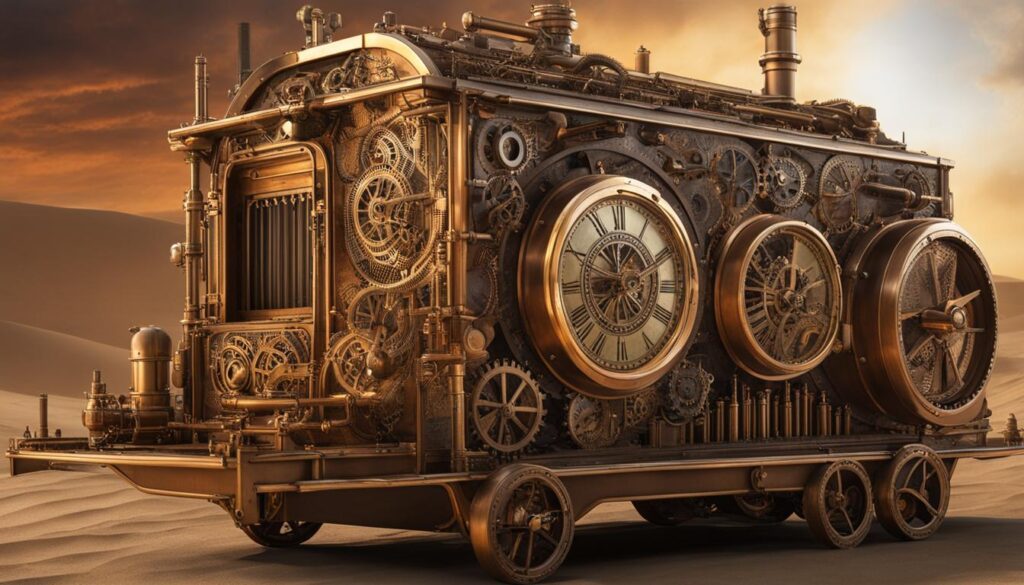
“We stepped inside the time machine, its gears whirring and steam billowing around us. With a flick of a lever, we were transported to a different era, surrounded by the sights and sounds of a bygone time. Steampunk and time travel entwined in a spectacular display of imagination and adventure.” – Anonymous
Exploring Temporal Dimensions
Time machines in steampunk literature offer authors the opportunity to explore the concept of time in unique and captivating ways. These inventions allow characters to witness historical events first-hand, interact with figures from the past or future, and navigate the twists and turns of alternate timelines. Whether it’s the quest for lost knowledge, the rewriting of history, or the unraveling of temporal mysteries, the inclusion of time machines adds depth and intrigue to steampunk narratives.
| Steampunk Time Machines | Features |
|---|---|
| Chrono-Engine | An enormous time-traveling contraption powered by steam, gears, and a pulsating aether crystal. |
| Temporal Cogmaster | A compact wrist-worn device that utilizes clockwork technology to shift time in small increments. |
| Vortex Vaporizer | A cylindrical apparatus that creates stable time vortices, allowing for precise temporal jumps. |
As the gears of the time machine rotate and the steam billows, the concept of time is unlocked, offering a realm of possibilities for both writers and readers in the world of steampunk.
Conclusion
As the curtain falls on the captivating world of the steampunk genre, one element stands tall and proud: technology. From the mesmerizing depths of aether to the intricate gears of clockwork systems, technology in steampunk narratives is a force to be reckoned with. It weaves together the charm of historical aesthetics with the innovation of futuristic elements, creating a truly unique literary experience.
In the vast expanse of steampunk literature, authors have embraced the opportunity to unleash their creative prowess, crafting gadgets and inventions that defy the boundaries of imagination. The result is a genre that enchants readers with its sense of wonder, adventure, and exploration.
Within the steampunk landscape, flying machines soar through the skies, propelled by the power of steam and a touch of magic. Rayguns, powered by mysterious energy sources, become the iconic weapons of choice for daring protagonists. And let’s not forget the heart and soul of the genre – steampower. It fuels the industrial world of steampunk, breathing life into trains, factories, and even time machines.
Steampunk stands as a testament to the boundless creativity and innovation that can be found in fiction. It invites readers to step into a realm where technology takes center stage, where the past and the future coexist, and where adventure knows no bounds. So, immerse yourself in the marvels of the steampunk genre, and embark on an extraordinary journey that will leave you craving for more.
FAQ
What role does technology play in steampunk narratives?
Technology is a central theme in steampunk narratives, shaping the genre and providing a distinct charm and aesthetic. It allows for creative inventions, gadgets, and systems that blend historical aesthetics with futuristic elements.
What are some examples of technology in steampunk stories?
Steampunk stories feature a variety of technologies such as aether, analog systems, automatons, clockwork mechanisms, flying machines, rayguns, steampower, and time machines. These elements add to the sense of wonder and adventure in the genre.
What is aether in the context of steampunk?
Aether is a versatile substance often featured in steampunk stories. It can be used as a power source or as a mysterious element connected to natural disasters. It adds to the sense of mystery and versatility in the genre.
What are analog systems in steampunk?
Analog systems in steampunk rely on the original form of waves and distinguish the genre from our digital world. These systems create a sense of nostalgia and add a unique atmosphere to steampunk narratives.
What are automatons and clockwork systems in steampunk?
Automatons are self-operating machines commonly found in steampunk stories. They range from clockwork singing birds to robot servants, adding to the sense of technological wonder in the genre. Clockwork systems, based on intricate clockwork mechanisms, serve various purposes and contribute to the mechanical and industrial aesthetic of steampunk.
What role do flying machines and rayguns play in steampunk?
Flying machines, such as airships and personal aircraft, are a staple of steampunk. They add a sense of adventure and exploration to the stories. Rayguns, on the other hand, are iconic weapons in steampunk, powered by various energy sources. They come in different designs and sizes, reflecting the style and personality of their users.
How does steampower and time machines feature in steampunk?
Steampower, based on steam technology, is foundational in steampunk narratives. It powers various elements such as trains, boats, and factory equipment, contributing to the industrial world of steampunk. Time machines, a popular aspect of science fiction, also make appearances, transporting characters to the past or future and adding excitement and adventure to the stories.
What is the significance of technology in steampunk literature?
Technology is a crucial aspect of steampunk literature, fueling the imaginative and captivating world of the genre. It showcases the creativity and innovation unique to steampunk, making it a beloved and distinctive part of the literary world.

